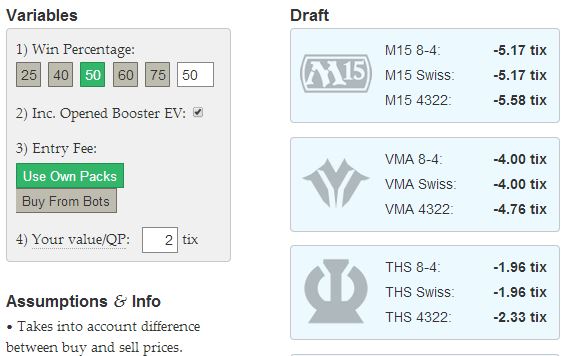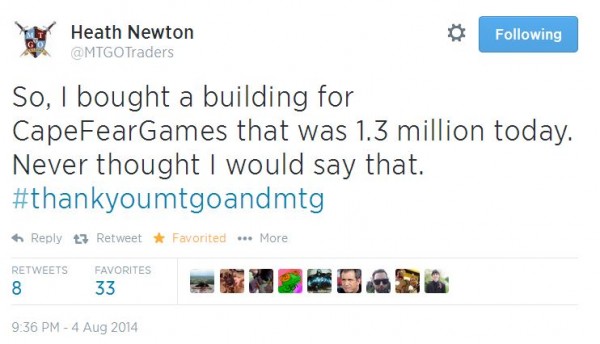Are you a Quiet Speculation member?
If not, now is a perfect time to join up! Our powerful tools, breaking-news analysis, and exclusive Discord channel will make sure you stay up to date and ahead of the curve.
Why are you buying MTGO cards right now? You should know the answer to that question.
It’s a deceptively simple one. "I need them for my deck." "I think they will go up." "I want to make money." But behind this simple question is a larger question that each of us need to answer: What are your goals with MTGO?

Setting goals is an important step in achieving them. When it comes to MTGO finance, most of us never stop to think about where we are going.
Though I never clearly articulated it, my goal, when I started two years ago, was to play MTGO for free. I was sick of spending money on the game and saw the MTGO model as something of a racket. I loved the convenience MTGO offered, but did not want to have to keep sinking money into each new set.
I’ve met my goal, and surpassed it, but doing so required an upfront investment of capital and a sustained investment of time. Was it worth it? From a financial perspective there is no doubt. Earlier this summer I cashed out my initial investment of several thousand dollars via PayPal while retaining an MTGO account that allows me to play (or trade for) any deck in any format. My account surplus will let me buy into future sets and will allow me to draft without worrying too much about the negative EV (though I still stress about it—that must be in my nature...)
I achieved this with a modest up front investment and with an average of five hours a week tracking and managing my portfolio (this time commitment waxed and waned.)
For me, that’s enough. I’ve made thousands of tickets with little in the way of real “work,” but it hasn’t been free money either. This isn’t my job, and in many ways it has been a distraction from family and career, the things that matter most to me. It has significantly reduced the amount of time I have available to actually play Magic, which is why I got into this in the beginning. Picking specs is a lot of fun, but managing a large portfolio has elements of drudgery.
Knowing what kind of time and capital you want to invest in this game is important, and should guide the targets you set for yourself. Here are some reasonable MTGO goals along with an overview of the time and money that it will take you to get there. Each is reasonable but will take a different level of commitment.
Goal: Draft for Free
You are fundamentally a limited player on MTGO, but hate how much it costs. You’re good enough to win your share of matches, but never enough to break even. You’ve turned to speculation to generate some income to offset the “slow bleed,” as Ryan Spain once called it.
Maybe you started paying attention to MTGO prices when you got burned selling cards too early or too late. Now you understand how the economy works and you wait for the optimum moment to sell your singles and boosters. Since you’re on MTGO a significant amount of time each week the opportunity costs are low—you buy and sell cards between rounds, and this can generate a small income that allows you to stay net positive.
This is an imminently obtainable goal. Depending on how much you draft and what your win rate is, you can pretty easily calculate what your “burn rate” is for MTGO via www.magicEV.com:

In the example above, a 50% win rate means you are shedding 5 tix a draft on M15, 4 tix on VMA, and 2 tix on THS. A higher win rate will reduce the cost of each draft, but note that you need an unrealistic 67% win rate at M15 before you break even. (See my previous article on the challenges of going infinite via draft.)
So, assuming you are not a Pro Tour caliber player, being a regular drafter is going to cost you money. Let's say you average two drafts a week with an average loss of 4 tix per draft (because you alternate formats). That's going to cost you about 400 tix per year.
That's a fair chunk of change, but can be pretty easily offset with an investment portfolio. Depending on how active you are, and how the markets break, you can net 400 tix a year with an initial investment of 500-1000 tix, a little bit of time, and close attention to the QS Forums.
In fact, for this type of speculation, a “booster only” strategy can get you where you want to go. You are not especially interested in Standard decks, so recreating a whole collection online is not a goal. If you mix a combination of booster specs (which are a steady and secure income) with some high-upside picks that present themselves once in a while you should be just fine.
There are four or five booster "cycles" a year, and each one offers roughly a 15-20% profit. I went back to my spreadsheet and in 2013, for example, there was M14 (which I bought at 2.9 tix, sold at 3.4 tix), GTC (bought at 2.9, sold at 3.5), RTR (bought at 3.38 sold at 3.92). I never found an investment window on DGM but I did find a window on Rise of the Eldrazi flashbacks (bought at 3.03, sold at 3.5).
Let's say that at the start of the year you invest in 500 tix worth of boosters. You follow the forums to find the right time to buy in and to sell. When you sell you then reinvest in whichever booster is undervalued.
If you can make a 15% profit each time your portfolio will quickly compound:
500 -> 575 -> 661 -> 760 -> 874 -> 1005
Within five booster cycles you have doubled your money on boosters alone. There is a time cost to this investment as well, since it takes a while to move 200 boosters. But if you are on MTGO anyway it is something you can do between rounds.
Goal: Build a Few Standard Decks
You are a constructed player in paper and want to be able to test online. You don’t want to have to recreate your whole collection on MTGO, but would like to have a few decks that you can play regularly to get in your reps and stay on top of the metagame.
Or maybe you read my article earlier this year about “going infinite by playing Constructed” and want to take advantage of the favorable terms MTGO offers to constructed players. But your online collection is pretty meager, so you are basically starting from scratch; you’ve built one of the “budget decks” but are missing some key cards to take it to the next level. Plus you don’t want to be tied to one sole deck—you want to be able to afford a couple Standard decks and have a small bankroll so you can weather a cold streak without reaching for your credit card.
Let’s say your goal is to build a couple tier 1 Standard decks. You’ll need 300 to 700 tix to do so based on Standard deck prices at MTGO Goldfish. Once you achieve that goal, if you are a decent constructed player you should be able to go infinite by gaming alone (so long as you are prudent with your tix and don’t blow your stack on drafts.)
If your preference is Standard you’ll need to stay on top of rotation cycles to avoid depreciation, and there will be some transaction costs involved. If you can afford a Modern or Legacy deck (initial investments of 500 to 1000 tix per deck) you don’t need to worry as much about this.
One of the nice things about this strategy is that, if implemented properly, you can actually play with your portfolio while you are building its value. This is not an ideal scenario—it’s best to keep your investment cards separate from your decks if possible, since it helps you make decisions on a more rational basis—but if you have a smaller portfolio it may be necessary.
This was a big part of my strategy starting out, and it helped me get a jump on my investment goals. There is something satisfying about seeing the value of your collection grow and working your way toward more powerful decks.
Goal: Draw Some Net Income
For a number of people, MTGO is a significant source of income (Paul Nemeth mentioned this in his interview.) Or maybe you are using your MTGO profits to subsidize your paper Magic collection.
The challenge with this goal is that drawing cash from your earnings means that your principal won’t grow. And if you hit a rough patch your principal could drop low enough that you miss out on investment opportunities. It’s easiest to sell off your liquid investments—tix and packs—but you want to make sure you retain enough liquidity to continue to generate revenues.
If regular income is your goal, you’ll want want to set a target for your monthly “cash out”. How much income do you want to generate, and how often do you plan to turn your virtual cards into hard currency?
You will also need to figure out how you want to sell your cards. There are three basic ways to get cash from cards: 1) Sell tix, either to people or to bots--going rate is usually 0.95 dollars per tix; 2) Sell a collection of cards directly to a bot (MTGO Traders and Cardbot, for example, will bid dollars for your collection; 3) Redeem sets and sell the paper sets on eBay.
All of these are viable options, and which you pursue will depend on how much time you have to invest. Sylvain's excellent article on this provides much more detail on how to cash out.
Goal: Make a Living Via MTGO
This is a tall order: pay the bills with a virtual card game. But it can be done.
To succeed you will need a bot chain. Magic speculation is time consuming, and the number of small transactions you will need to execute each month to pay the rent are beyond the reach of human hands. It’s possible to make high margin investments without a bot, but doing so exposes you to risks that you probably don’t want to take if this is your primary source of income.
There are a number of different bot models and bot businesses. There are full service bots connected with a large web inventory. There are bots that exist primarily to acquire complete sets that can be redeemed and sold into the paper market. There are booster-only bots and Standard-only bots and Legacy and Eternal specialists. There are bots that seek to always have the lowest prices and those that seek lower volume and higher margin.
Almost all these strategies are profitable. Finding the right niche in the market that meets your time constraints, provides cash flow, and allows you to achieve your profit goals is key. MTGO Traders is the industry leader, and Heath recently used MTGO profits to acquire a building worth $1.3 million.

But building his business required years of hard work and operating at scale—he has 17 full time employees, including eight MTGO buyers. (You can read about his business here.)
Of course, if your costs of living are low you might be able to make it happen. In many parts of the world, if you can generate five hundred dollars a month in profit you can live a middle class lifestyle. That’s an entirely achievable goal if you start with an adequate bankroll.
Conclusion
Take a minute and think about your goals. How much revenue do you want to make via MTGO this year? What would success look like? And how far are you willing to go to achieve it?
On a personal note, this summer I achieved the goal I set for myself. With my current collection and stash of boosters I feel that I can play Magic Online indefinitely without investing another dollar into this game. Magic investment has never been about making money for me so much as it has been about not spending it and about having fun. That said, I have a lot going on in my life and I want to reduce the time and energy I put into managing my virtual collection.
As a result, I will be stepping back for a while from MTGO finance. I’ll still participate in the forums and may write an article once in a while, but I won’t be as active as I have been within this community.
It’s been a lot of fun working with you all as I build my collection, and I hope you are able to meet your goals. Focus on what matters, invest wisely and, most importantly, have fun.
-Alexander Carl (@thoughtlaced)






Great article. The part about botting piqued my interest, I would love to see a post on the costs of starting a bot chain, and the rakes that people charge to use their software.
Good luck on your break Alex
Thanks Timmy. There are a couple good forum posts on starting a bot, but I agree, it’s an area that QS can explore in more depth in the future!
You make a mistake in your first calculation for people who want to pay for the drafts.
You start with an investment of 500 tix and you keep reinvesting the tix the whole year!
So you don’t have any tix left for drafts! If you start with an empty collection, that’s an investment of 900 tix. I don’t see many people starting from scratch with such huge investment!
These calculations assume you don’t touch the principal for a year (i.e. you are keeping your “investment” budget and your “spending” budgets separate and paying yourself back at the end of the year). You are right that most people don’t operate that way (though probably more should.) If you want to draft for free and draw down the principal as you go you can do that too, but you will need a larger starting investment to meet your goals.
I agree most people wouldn’t start from scratch with such a large investment. But most people who employ this strategy wouldn’t be starting from scratch–most will have other cards they could sell to get the principal and their draft bankroll. Make sure to check out my article a couple weeks ago about finding “hidden money” within your collection and putting it to work for you!
I try to draft for free using QS, thourough observation of price fluctuations and of course moneydrafting (never pass a card that’s worth half a booster).
When i started playing online I couldn’t play too much because it costs a lot (compared to other hobbies i could do). But two years ago i started taking an interest in the financial side of the game, and things went up from then. Last year i invested like 100 tics three times, this year i still have to make my first investment and it doesn’t look like i’m gonna have to.
I play like 5 drafts a week, all Swiss, winning around 60-65% of my matches. That combined with decent picks (eidolon of great revel today) and investments (made 30 tic on VMA FOW’s this week) keeps me drafting without paying.
I hope i can continue to do this, allthough my bankroll is smaller then I would like (3-400 free tix, same amount into cards/boosters).